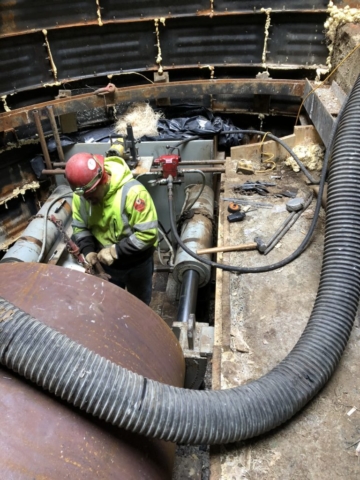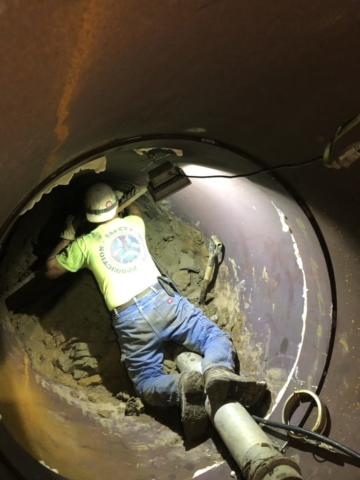ORI Emergency
Rehab
About This Project
The ORI was originally constructed in 1958, with traditional hand-mining tunneling methods using steel ring beams and wood lagging. It runs through the heart of downtown Louisville, KY, in the business, entertainment, and hospitality district along historic Main Street. Detailed studies by MSD estimated that certain sections had significant concrete loss, approaching the full depth of the original 12” cross section. Despite the impact to downtown businesses, commuters, and tourists, MSD closed portions of Main Street to protect the public from any collapse, while simultaneously reaching out to the design and contracting community for immediate assistance.
Ulliman Schutte Construction and Brown & Caldwell were ultimately hired by MSD under an emergency procurement to design and expedite the repairs, while minimizing impact on the community. The project team rapidly developed an on-site rehabilitation plan that utilized a single existing access point at the 4th and Main Street intersection. Flow diversion plans were jointly developed and field tested to send minor portions of the flow through alternate facilities. However, since the ORI carries approximately 40% of MSD’s flow to its treatment center, a significant portion of the flow had to be pumped around the section to be rehabilitated.

Diverting this substantial flow to a temporary pumping station required several gate replacements, gate upgrades, and temporary bulkheads. Temporary pumping was accomplished via seven 18” centrifugal pumps from Thompson Pump that used an efficient blend of silent diesel and variable-speed electric power. The temporary pump station was manned 24 hours per day, and operated in close coordination with MSD’s other facilities, to deliver approximately 40 MGD through four 18” HDPE discharge pipes strategically routed around downtown to avoid inconvenience to the general public.
After incoming flows were diverted, approximately 1,400 LF of the ORI was rehabilitated via man entry, with PVC strip liner panels from Danby installed by Boyer, Inc. During the grouting portion, a void under Main Street was discovered, which presented significant dangers to the workers below the suspended street, and to the public topside. Additional trenchless methods were employed to repair the sewer collapse, with robots and ground stabilization from above, while installing steel ring beams and lagging within the affected sewer section for worker protection from below. Midwest Mole utilized cellular grouting to fill this very large void under Main Street.
In addition to the mainline ORI trenchless repair, MSD elected to mitigate three downtown Combined Sewer Overflows (CSOs) as part of this project. The project team accomplished this goal by installing three new trenchless connections into the ORI. The side street shafts for drop structures and tunneling work were completed by Midwest Mole, with no community impacts along Main Street. Two of these shafts were 15’ wide and 30’ deep, and one shaft was a trench box shaft at a 20-foot depth. Each work site was in the middle of downtown traffic, and space to maneuver was tight. Constant contact with impacted property owners was required to facilitate existing business while our work was being constructed. For example, our team had to move in and out of work sites to allow the Kentucky Center to host their regularly scheduled shows.
One tunnel was a 42” Hobas pipe that was direct bored, while steel casing pipes with 42” Hobas carrier pipes were used in the other two crossings. All three blind underground connections to the ORI were completed in perfect alignment, utilizing underground soil stabilization for bracing and sealing during the connection work. Led by Josh Miller and Jeremy Beckner, this complicated project was completed in a short time frame. Jeremy did a great job building this project, and working with our client and subcontractors from beginning to end.
With constant design changes, Midwest Mole overcame a myriad of obstacles to complete our work. Francisco Romo did a terrific job installing all three tunnels via hand mining, some days getting up to 30’ of five-foot-long 54” casings. Midwest Mole was involved from the beginning, and handled all associated design work related to our scope, from locating existing utilities to shaft locations, pipe sizes, all submittals, shaft design, structure design, MOT recommendations, scheduling, survey, elevation verification, construction, and all field changes that came along with the construction.
Despite the numerous setbacks associated with record rain events and river flooding, the project was completed within its original schedule and budget, without any recordables or lost time accidents. Flow capacity within the ORI was restored such that it was confidently placed back into service for generations to come. The project not only succeeded, it surpassed all expectations by every measure in terms of solution optimization, collaboration, flexibility, quality, delivery time, cost savings, and impact to the community and stakeholders.
Project Details
- OwnerMSD Louisville and Jefferson County
- ScopeThree runs totaling 150' of 54" steel casing for 42" sewer via hand mine, related tie-in at existing tunnel, three 15' round by 30' deep liner plate work shafts
- DateAugust 2019
Project Gallery
Work With Us
Are you interested in leveraging Midwest Mole's industry-best services for your project? Drop us a line with some basic information about the job, and we'll get back to you with a pricing estimate as soon as possible.
Get a Quote













